
In baseball, a home run is scored when the ball is hit in such a way that the batter is able to circle the bases and reach home plate safely in one play without any errors being committed by the defensive team. A home run is usually achieved by hitting the ball over the outfield fence between the foul poles without the ball touching the field.
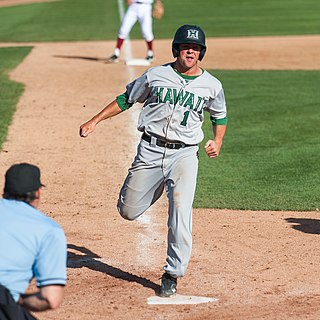
In baseball, a run is scored when a player advances around first, second and third base and returns safely to home plate, touching the bases in that order, before three outs are recorded and all obligations to reach base safely on batted balls are met or assured. A player may score by hitting a home run or by any combination of plays that puts him safely "on base" as a runner and subsequently brings him home. Once a player has scored a run, they may not attempt to score another run until their next turn to bat. The object of the game is for a team to score more runs than its opponent.
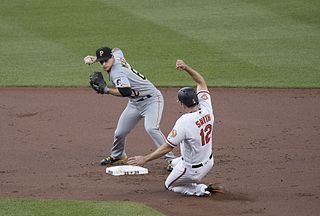
In baseball and softball, a double play is the act of making two outs during the same continuous play. Double plays can occur any time there is at least one baserunner and fewer than two outs.
In baseball, a triple play is the act of making three outs during the same play. There have only been 735 triple plays in Major League Baseball (MLB) since 1876, an average of just over five per season.

In the game of baseball, the official scorer is a person appointed by the league to record the events on the field, and to send the official scoring record of the game back to the league offices. In addition to recording the events on the field such as the outcome of each plate appearance and the circumstances of any baserunner's advance around the bases, the official scorer is also charged with making judgment calls that do not affect the progress or outcome of the game. Judgment calls are primarily made about errors, unearned runs, fielder's choice, the value of hits in certain situations, and wild pitches, all of which are included in the record compiled. This record is used to compile statistics for each player and team. A box score is a summary of the official scorer's game record.
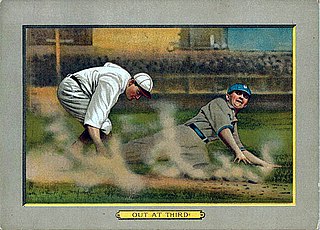
In baseball, an out occurs when the umpire rules a batter or baserunner out. When a batter or runner is out, they lose their ability to score a run and must return to the dugout until their next turn at bat. When three outs are recorded in a half-inning, the batting team's turn expires.

Throughout the history of baseball, the rules have frequently changed as the game continues to evolve. A few common rules most professional leagues have in common is that four balls is a base on balls, three strikes is a strikeout, and three outs end a half-inning.
In baseball, a force play is a situation in which a base-runner is compelled to vacate their starting base and attempt to advance to the next base. When a runner is forced to advance to a base, they are forced out if an opponent with possession of the ball reaches that base before they do. Runners are no longer forced to advance to the next base if any runner behind them on the base-paths is put out.
A hidden ball trick is a play in which a player deceives the opposing team about the location of the ball. Hidden ball tricks are most commonly observed in baseball, where the defence deceives the runner about the location of the ball, to tag out the runner. In goal-based sports, the offence deceives the defence about the location of the ball, in an attempt to get the defence running the wrong way, such as in a fumblerooski.
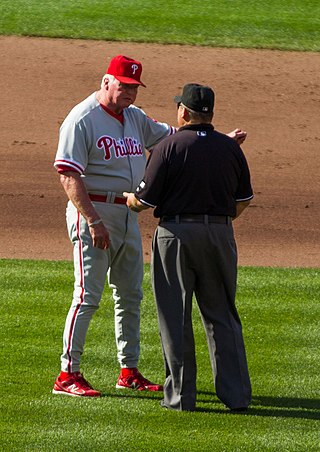
In baseball, an appeal play occurs when a member of the defensive team calls the attention of an umpire to an infraction which he would otherwise ignore.
In baseball, interference occurs in situations in which a person illegally changes the course of play from what is expected. Interference might be committed by players on the offense, players not currently in the game, catchers, umpires, or spectators. Each type of interference is covered differently by the rules.
In baseball, obstruction is when a fielder illegally hinders a baserunner running within the basepath. Baserunners are generally permitted to run from base to base without being physically blocked or hindered by a fielder. The only time that a fielder is not obligated to "get out of the way" of a baserunner is when the fielder is fielding a hit ball or in possession of the ball.
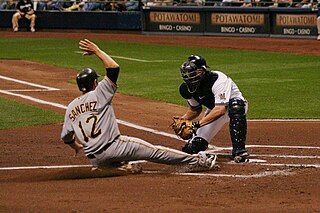
In baseball, blocking the plate is a technique performed by a catcher to prevent a runner from scoring. The act of blocking the plate accounted for most of the physical contact in Major League Baseball prior to the 2014 season, when it was outlawed except when the catcher already has possession of the ball.
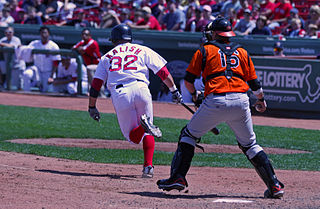
In baseball and softball, an uncaught third strike occurs when the catcher fails to cleanly catch a pitch for the third strike of a plate appearance. In Major League Baseball (MLB), the specific rules concerning the uncaught third strike are addressed in Rules 5.05 and 5.09 of the Official Baseball Rules:
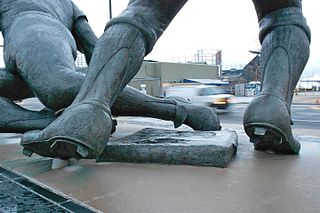
In baseball, a neighborhood play is a force play in which a fielder receiving the ball in attempting to force out a runner at second base, catches and quickly throws the ball to first base in a double play attempt without actually touching second base, or by touching second base well before catching the ball. By every rules code, such a play is not an out, because to record a force out, the fielder with the ball must actually touch a force base before the forced runner arrives.
The 2009 Los Angeles Dodgers season saw the team defend their National League West title while earning the best record in the National League, and marked the 50th anniversary of their 1959 World Series Championship. The Dodgers reached the NLCS for the second straight season only to once more fall short in five games against the Philadelphia Phillies.

The 2009 National League Division Series (NLDS) consisted of two concurrent best-of-five game series that determined the participating teams in the 2009 National League Championship Series. Three divisional winners and a "wild card" team played in the two series. The NLDS began on Wednesday, October 7 and ended on Monday, October 12. TBS televised all games in the United States. The matchups were:

Major League Baseball (MLB) uses instant replay review to allow league officials to review certain types of plays in order to determine the accuracy of the initial call of the umpires on the field. Reviews may be initiated either by a team's manager with limitations or by the umpires themselves. All instant replay reviews are examined by umpires at the Replay Command Center in New York City, who have the final decision as to whether to uphold or overturn the initial call.

The 2010 National League Championship Series (NLCS) was a best-of-seven game Major League Baseball playoff series that pitted the winners of the 2010 National League Division Series—the Philadelphia Phillies and San Francisco Giants—against each other for the National League Championship. The Giants would defeat the Phillies, four games to two, to advance to their first World Series since 2002. The series, the 41st NLCS in league history, began on October 16 and ended on October 23. The Phillies had home field advantage as a result of their better regular-season record. The Phillies hosted Games 1, 2 and 6, while the Giants were at home for Games 3, 4 and 5.

In 2019, the Washington Nationals advanced to the World Series for the first time in franchise history and also Washington, D.C.'s first appearance in the World Series since the American League's Senators in 1933. They proceeded to defeat the Houston Astros in seven games to win the franchise's first World Series championship, and the first for Washington, D.C. since 1924.













